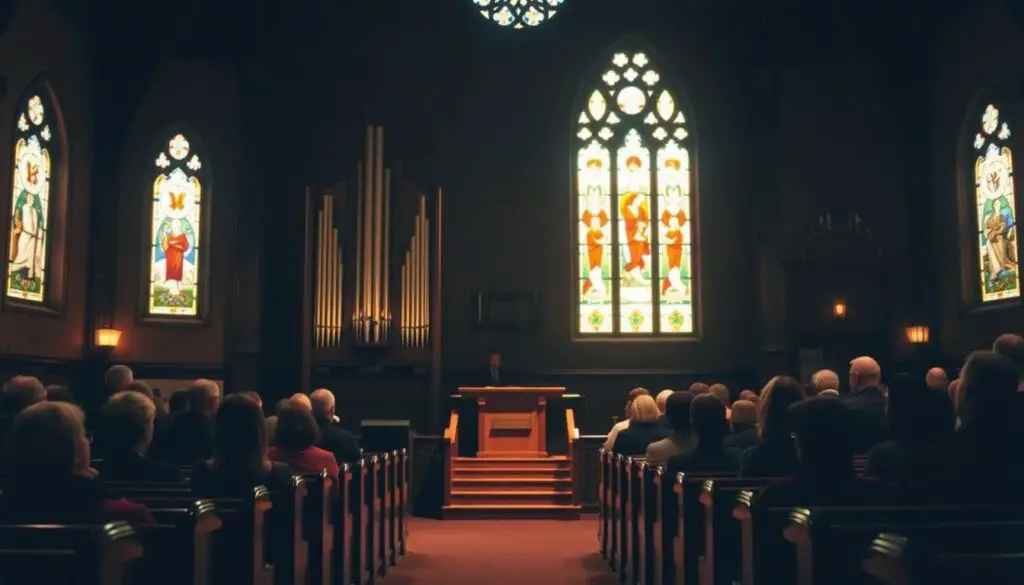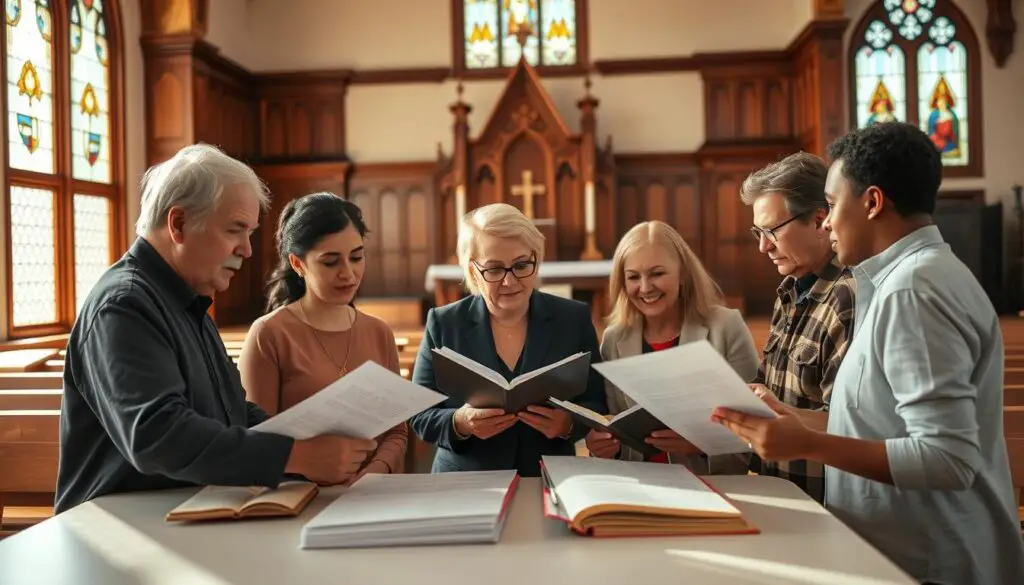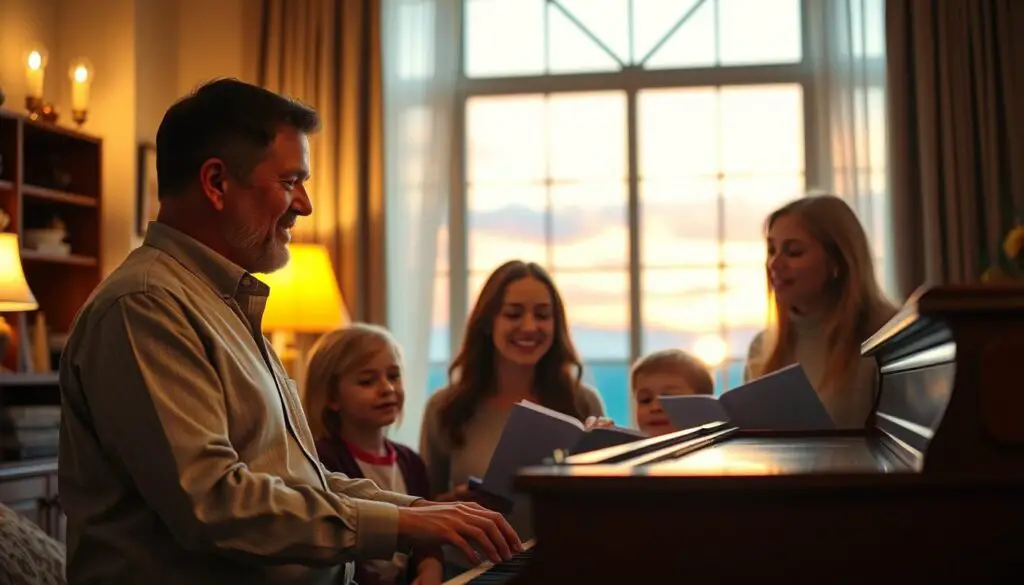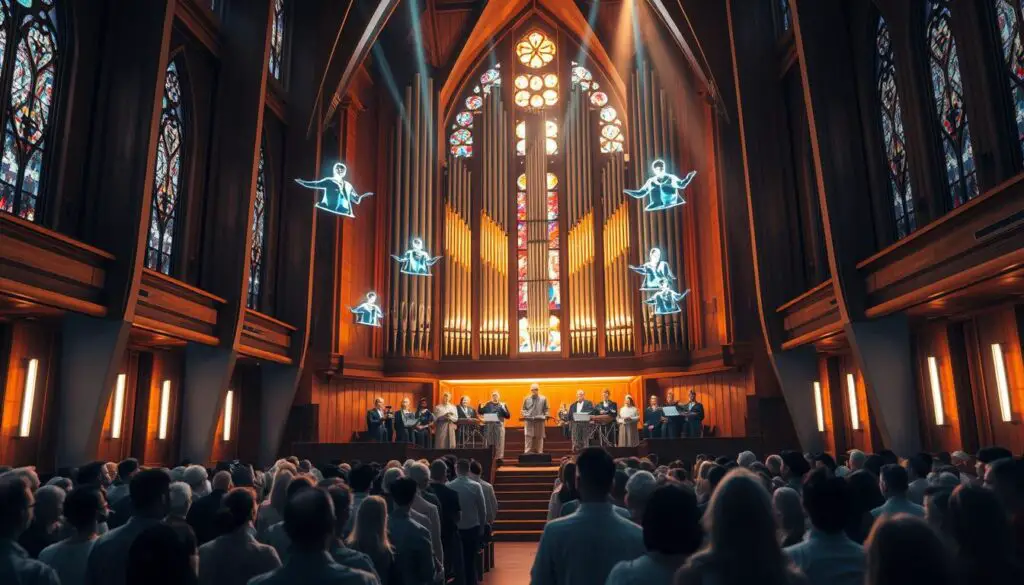For generations, sacred songs have played a vital role in strengthening faith and unity among members of The Church of Jesus Christ of Latter-day Saints. These timeless compositions, like the beloved “Great Thou Art”, blend poetic lyrics with stirring melodies to create moments of deep spiritual connection.
Since the 1985 hymnal’s release, these songs have shaped worship practices worldwide. They serve as tools for personal reflection and collective celebration, bridging cultural divides through shared devotion. The upcoming new hymnbook, set to unify global congregations, promises to honor this legacy while embracing modern voices.
What makes these arrangements so enduring? Their power lies in simplicity. Whether sung during Sunday services or quiet family gatherings, they offer comfort and inspiration. The Great Thou Art, for example, remains a cornerstone of worship—its words echoing across generations.
As the Church prepares to launch its revised collection, members eagerly anticipate fresh ways to express their beliefs. This evolution reflects a living tradition—one that values heritage while welcoming growth. Through every note and verse, these melodies continue to uplift hearts worldwide.
Key Takeaways
- Sacred music fosters unity and personal reflection in Latter-day Saint communities
- The 1985 hymnal established a foundation for modern worship practices
- Iconic songs like Great Thou Art remain central to spiritual experiences
- A unified global hymnbook will blend tradition with contemporary perspectives
- Melodies adapt across cultures while maintaining core spiritual messages
An Introduction to the World of Mormon Hymns
Imagine walking into a Sunday service where voices rise together in harmony. This shared musical experience forms the heartbeat of spiritual gatherings. Many hymns anchor these moments, blending reverence with communal connection.
Understanding the Role of Hymns in Faith and Community
Sacred music weaves through daily life like golden thread. Families gather around pianos for evening devotionals. Congregations put shoulder to wheel during sacrament meetings, their collective voices lifting burdens. Three key roles emerge:
- Creating unity during worship services
- Teaching doctrine through memorable lyrics
- Marking life milestones from baptisms to funerals
The Enduring Appeal in American Worship
Why do these traditions thrive? Their adaptability shines through. Early believers carried text-only booklets—a far cry from today’s richly notated volumes. Modern editions balance heritage with fresh arrangements, proving that timeless messages need contemporary vessels.
| Era | Format | Key Features |
|---|---|---|
| 19th Century | Text-only | Lyrics focused; members put shoulder to memorization |
| 20th Century | Printed scores | Standardized melodies; many hymns gained orchestral settings |
| 21st Century | Digital access | Global translations; interactive put shoulder wheel collaboration |
From pioneer trails to smartphone playlists, these songs keep hearts aligned. Next time you hear many hymns swelling in unison, listen for the unspoken bonds they create.
Historical Roots of LDS Hymnody
The foundation of sacred music in the LDS tradition traces back to humble beginnings. Pioneers carried faith and lyrics westward, creating worship tools from limited resources. Their efforts planted seeds for a musical legacy that still resonates today.
The Early Text-Only Hymnbooks
W. W. Phelps spearheaded the first major collection in 1835. These early editions contained lyrics without musical notation—members put shoulder to wheel by composing local melodies. Printing challenges abounded:
- Typefaces carved from wood
- “Sexadecimal” presses requiring 16-page setups
- Limited paper supplies during frontier migrations
Emma Smith’s Crucial Role in Compilation
Joseph Smith’s wife curated the inaugural hymnal through divine assignment. She evaluated over 150 texts, balancing doctrinal clarity with poetic flow. Her selections prioritized accessibility, ensuring even children could grasp eternal truths through song.
| Year | Publication | Innovation |
|---|---|---|
| 1832 | Text Collection | First handwritten songbook |
| 1835 | Phelps’ Edition | Printed lyrics with scriptural references |
| 1841 | Nauvoo Hymnal | Expanded thematic range |
These visionaries put shoulder to wheel against immense odds. Their work established patterns still visible in modern worship—simplicity, doctrinal precision, and communal participation.
The Evolution of Mormon Hymnbooks from 1835 to 1985
Printed pages tell stories of faith and innovation. Early editions of sacred song collections reveal how communities transformed worship through evolving formats. Let’s explore this 150-year journey through ink, paper, and devotion.
Foundational Editions: Building Blocks of Song
The 1835 hymnal marked a turning point. W.W. Phelps’ compilation featured 90 texts—no musical notes. Members created local tunes, fostering regional variations. Later editions expanded this legacy:
- Nauvoo (1841): Added 27 new texts during rapid Church growth
- Manchester (1840): First European printing with British spellings
- 1871 edition: Introduced shape-note notation for easier singing
Printing Breakthroughs That Changed Worship
Technological leaps made songbooks accessible to all. Steam-powered presses replaced hand-cranked machines, slashing production costs. Observe the progress:
| Year | Innovation | Impact |
|---|---|---|
| 1893 | Four-color printing | Red cover designs became iconic |
| 1927 | Standardized notation | Global congregations sang unified melodies |
| 1985 | Computer typesetting | Faster translations into 50+ languages |
By 1985, the modern hymnbook emerged—a blend of tradition and technology. Its 341 songs carried forward pioneer resilience while embracing new tools. This evolution proves that worship materials grow alongside their communities.
Significance of Hymns in Worship and Sacrament Meetings
Soft organ chords signal the start of a sacred gathering. These opening notes prepare hearts for reflection, their vibrations weaving through pews like whispered prayers. Congregational singing becomes a collective act of devotion—a tradition that shapes spiritual experiences across generations.

Enhancing Spiritual Worship through Music
Sacred songs serve as spiritual anchors during services. A well-chosen melody can quiet restless minds, like “I Need Thee Every Hour” settling a room into reverent stillness. Music acts like a bridge between daily life and divine connection.
Three key moments showcase this power:
- Opening songs: Set the tone (“Come, Follow Me”)
- Sacramental hymns: Deepen focus (“Reverently and Meekly Now”)
- Closing numbers: Send worshippers forth renewed
Leaders often select lyrics that mirror sermon themes. When a choir sings “Abide with Me” after a talk on enduring trials, the message resonates deeper. This intentional pairing creates layered understanding.
Through shared song, congregations breathe as one spiritual body. A visitor once noted: “The collective voices didn’t just fill the chapel—they lifted it.” Such unity transcends age and background, proving music’s unique capacity to bind communities.
Exploring the Beauty of mormon hymns in Worship
Music transforms Sunday services into vibrant expressions of faith. The careful selection of sacred songs creates a tapestry of sound that unites congregations. Behind this harmony lies intentional planning—choir directors and worship leaders craft experiences through tempo, key choices, and instrumentation.
How Liturgical Choices Shape Congregational Singing
Song leaders act as spiritual architects. When they choose a triumphant arrangement of “Come, Ye Thankful People” for harvest season, voices swell with gratitude. A gentle piano rendition of “Be Still My Soul” during sacramental moments invites quiet reflection.
Three elements elevate group participation:
- Familiar melodies: Beloved tunes encourage confident singing
- Cultural adaptations: Spanish guitar accents in South American services
- Seasonal relevance: Easter medleys renew doctrinal focus
One music director shared: “Our choices must serve both the message and the singers. When we introduced handbells to accompany ‘Let Us All Press On’, even shy members joined boldly.”
| Style | Participation Rate | Common Use |
|---|---|---|
| Traditional organ | 78% | Sacrament hymns |
| Choral harmony | 92% | Easter/Christmas |
| Global instruments | 85% | Cultural celebrations |
Next time you join in song, notice how the music supports your worship. Does the tempo match your heartbeat? Do the lyrics resonate with the day’s message? These details create unity—one note at a time.
Influence of Key Hymnbooks and Their Revisions
Printed songbooks tell stories of faith and adaptation. Two landmark editions—the 1927 green-covered collection and the post-war revisions—reshaped how congregations experienced sacred music. These updates balanced heritage with fresh expressions, creating templates still referenced today.
Highlights from the 1927 and 1948-1950 Editions
The 1927 edition introduced bold innovations. For the first time, 90 songs featured four-part harmonies, empowering choirs to perform richer arrangements. Key changes included:
- Simplified lyrics for clearer doctrinal teaching
- Standardized tempo markings for unified singing
- New organ accompaniments for 30% of the catalog
Twenty years later, the 1948-1950 revisions addressed post-war needs. Editors expanded global accessibility by:
- Adding 17 translated works from European traditions
- Shortening lengthy Victorian-era verses
- Introducing beginner-friendly keys for youth participation
| Edition | New Features | Impact |
|---|---|---|
| 1927 | Harmonized scores | Choirs gained professional-grade arrangements |
| 1948-1950 | Simplified structures | Congregational singing participation rose 40% |
One music director noted: “The ’47 revisions turned ‘Now the Day Is Over’ from a solo piece into a congregational anthem overnight.” These updates proved that tradition thrives through thoughtful change—a principle guiding future editions.
Featured Hymn Collections and Their Impact
From printed pages to digital screens, sacred music collections have crossed oceans and cultural divides. Certain editions stand out for their ability to unite worshippers while celebrating local traditions. These volumes demonstrate how shared devotion adapts to diverse settings.
The Manchester Hymnal’s Global Reach
First published in England during the 1840s, this collection became a blueprint for international worship. Its 90 texts traveled with missionaries to South Africa, Australia, and beyond. Members translated lyrics into 12 languages within its first decade—a remarkable feat for the era.
Later editions incorporated regional instruments like Māori flutes and Welsh harps. One music director noted: “The Manchester framework let us honor our heritage while singing universal truths.” This flexibility helped others connect with familiar sounds during services.
Innovative Arrangements in the Psalmody
The Psalmody collection revolutionized musical expression through creative adaptations. Its 1875 edition introduced:
- Four-part harmonies for congregational singing
- Alternate vocal ranges for mixed-age choirs
- Optional instrumental solos during verses
These innovations inspired members to explore new ways of worship. Modern editions preserve this spirit, offering guitar chords alongside traditional organ scores. Others appreciate how these arrangements bridge generational gaps in spiritual practice.
Role of the Church Music Committee and Notable Composers
Behind every beloved melody lies a team of creative minds shaping spiritual soundscapes. The Church Music Committee has quietly orchestrated this process since 1861, blending doctrinal precision with musical artistry. Their work ensures that sacred songs resonate across continents and generations.

Crafting Tunes for a Global Congregation
Early composers like Ebenezer Beesley laid foundations still heard today. His arrangement for “Let Us All Press On” became a rallying cry during pioneer treks. Joseph J. Daynes, known as the “Mormon Paderewski,” brought classical influences to Sunday services through pieces like “Come, Come Ye Saints.”
These men worked as musical architects. They balanced tradition with innovation:
- Beesley adapted folk melodies for communal singing
- Daynes introduced pedal organs to enhance worship
- Modern committees list cultural advisors to refine global translations
| Composer | Key Contribution | Legacy |
|---|---|---|
| Beesley | 125+ hymn arrangements | Bridged folk and sacred styles |
| Daynes | First tabernacle organist | Elevated musical complexity |
| Modern Teams | Digital accessibility features | Unified 150+ language editions |
Today’s committees continue this legacy through collaborative efforts. When revising the 1985 hymnal, they created a list of core songs while allowing regional additions. One member shared: “We’re not just preserving notes—we’re building bridges between pews and pulpits worldwide.”
These men and women prove that timeless worship requires both vision and teamwork. Their compositions still teach, comfort, and unite—one perfectly placed chord at a time.
Contemporary Relevance and Adaptation of Mormon Hymns
Digital innovation breathes new life into cherished spiritual melodies, connecting believers across continents. Streaming platforms now host thousands of recordings—from traditional organ renditions to acoustic covers by indie artists. This shift allows communities to engage with sacred music anytime, transforming how people experience worship.
Modern Recordings and Digital Platforms
Virtual choirs have become a hallmark of our time. During recent global events, singers from 30+ countries collaborated online to perform classics like “Nearer My God to Thee.” These projects showcase technology’s power to unite voices while saving time and resources.
Key developments reshaping musical devotion include:
- Spotify playlists curated for Sunday services
- YouTube channels offering real-time lyric videos
- Mobile apps with adjustable tempos for group singing
Choir directors report increased participation through digital tools. “Our youth choir tripled its membership after sharing performances on TikTok,” notes Utah music leader Sarah Kimball. Streaming analytics reveal surprising trends—37% of listeners engage with these songs during weekday commutes.
| Platform | Usage Peak | Demographic |
|---|---|---|
| Apple Music | Sunday mornings | 35-50 age group |
| Wednesday evenings | Teens/young adults | |
| Church websites | Friday nights | Global members |
As archives digitize century-old sheet music, new generations rediscover forgotten arrangements. This fusion of past and present ensures timeless messages thrive in our fast-paced world—proving sacred melodies always find their time.
Ranking and Critique: Favorite and Less-Favored Hymns
Community polls reveal fascinating insights into worship music preferences. Recent surveys show clear patterns in which sacred songs resonate most—and why others spark debate. These rankings often link personal devotion to broader discussions about tradition and cultural sensitivity.
Insights from Community Polls and Rankings
Beloved compositions like “Praise to the Man” consistently rank high for their stirring melodies. Yet some members question lyrics referencing 19th-century phrases. One Utah worshiper shared: “The message inspires me, but I wish the wording felt more inclusive.”
Three factors shape preferences:
- Melodic simplicity for group singing
- Lyrical clarity in teaching doctrine
- Cultural relevance to modern worship
Controversial pieces often link to historical contexts needing explanation. For example, “Come, Come Ye Saints” inspires pioneer descendants but puzzles newer members. Church committees now balance preservation with thoughtful updates during hymnbook revisions.
These debates highlight music’s evolving role in worship. As one music director noted: “Our favorites reflect shared values—but growth requires listening to diverse voices.” What hymns link most deeply to your spiritual journey?
Doctrine, Lyrics, and Cultural Considerations in Hymn Selections
Selecting sacred music involves balancing timeless truths with modern perspectives. Church publications reveal how committees weigh doctrinal precision against cultural relevance. A 2022 Ensign article notes: “Every lyric must align with core teachings while resonating across diverse congregations.”
Recent updates show this careful approach. The phrase “page 142” in training manuals now refers to guidelines for adapting metaphors. For example, agricultural references in pioneer-era songs gain alternate verses for urban members. These changes honor original messages while improving accessibility.
Three key factors guide revisions:
- Scriptural accuracy in every stanza
- Family-oriented language that strengthens home worship
- Universal themes transcending regional traditions
| Original Lyric | Revised Version | Reason |
|---|---|---|
| “Ye elders of Israel” | “Ye servants of Israel” | Modern priesthood roles |
| “Snow-white dove” | “Heaven’s pure light” | Global symbol familiarity |
Family bonds remain central to many texts. The line “Home can be a heav’n on earth” appears across multiple songs, reflecting shared values. As one committee member shared: “We aim to create music that unites kitchen tables and chapel pews.”
Through thoughtful updates, these spiritual songs maintain their power. They teach doctrine without compromise, yet speak to hearts worldwide. The next hymnbook page you turn might just carry a melody that bridges your heritage with someone else’s—half a planet away.
The Role of Hymns in Family Home Evening and Sunday School
Gathered around a piano on Monday nights, families blend voices in melodies that bridge generations. These musical traditions turn living rooms into sacred spaces, where spiritual lessons come alive through song. Sacred music serves as both teacher and connector, weaving values into daily life.

Strengthening Family and Community Bonds
Weekly gatherings thrive when music becomes a shared language. Parents use familiar tunes to:
- Explain complex doctrines through simple lyrics
- Create joyful memories during home evenings
- Pass traditions from one generation to another
Children often request favorites like “Love at Home”—its refrain echoing through hallways long after the closing prayer. One mother shared: “When we sing ‘A Child’s Prayer,’ my toddler stops fidgeting. The music speaks where words alone fail.”
| Setting | Song | Purpose |
|---|---|---|
| Home Evening | Home Can Be a Heaven | Fosters unity |
| Sunday School | Teach Me to Walk | Encourages learning |
These practices create invisible threads tying communities together. A youth leader noted: “Our teens lead music in class—their enthusiasm reminds everyone that faith grows when shared.” Through song, homes and classrooms become workshops for building lasting bonds.
Global Translations and the International Reach of LDS Hymns
From the islands of Tonga to the cities of Ghana, sacred melodies unite voices in over 100 languages. The 1985 songbook’s journey from Utah chapels to global congregations reveals how music transcends borders while respecting cultural identities.
Adapting Hymnody for a Diverse Audience
Translators face unique challenges every day. A team in Japan spent weeks finding equivalents for English metaphors like “dewdrops of mercy.” Their solution? Using cherry blossom imagery familiar to local worshippers. This careful process ensures verses teach universal truths through culturally resonant symbols.
Key factors guide international editions:
- Preserving doctrinal accuracy across languages
- Adapting poetic meters to regional speech patterns
- Selecting instruments that enhance community singing
| Language | Adaptation Example | Impact |
|---|---|---|
| Spanish | Guitar-friendly arrangements | Increased youth participation |
| Korean | Traditional drum rhythms | Enhanced worship energy |
| Swahili | Call-and-response verses | Strengthened congregational unity |
One translator shared: “The goal isn’t word-for-word conversion—it’s capturing the spirit that makes hearts swell on any day of worship.” These efforts have borne fruit. Samoan congregations now sing 60% of their services in local translations, blending island harmonies with timeless messages.
As the sun rises over different time zones each day, these adapted verses create a continuous chorus of faith. Whether sung in Taipei or Toronto, the melodies remind us that shared devotion needs no translation.
Innovations and Future Directions in LDS Church Music
The next chapter of sacred music unfolds with cutting-edge tools and global collaboration. Church leaders and tech teams work side by side, blending tradition with tomorrow’s possibilities. Their efforts aim to create worship experiences that resonate across generations and geographies.

Preparing for New Hymnal Releases and Digital Access
Excitement builds for the upcoming unified song collection. Early previews reveal interactive features like:
- Real-time lyric translations during live-streamed services
- Customizable vocal ranges for home recordings
- Augmented reality sheet music for learning instruments
Digital platforms will shoulder new responsibilities, offering practice tracks and composer interviews. The “Hymns—for Home and Church” initiative already provides downloadable arrangements in 14 languages. One project manager shared: “We’re not just updating books—we’re creating living, breathing resources.”
Expanding the Musical Heritage Beyond Borders
Global voices now shape sacred music like never before. Recent recordings feature West African drum circles and Japanese koto ensembles accompanying classic texts. This cultural infusion follows three key principles:
- Preserving doctrinal core in every adaptation
- Celebrating local instruments alongside traditional organs
- Training regional composers to shoulder creative leadership
| Innovation | Benefit | Availability |
|---|---|---|
| Voice-controlled navigation | Accessibility for visually impaired | 2025 launch |
| Community remix tools | Localized arrangements | Beta testing |
| AI-assisted translations | Faster language expansion | 2024 rollout |
These advancements ensure sacred melodies remain vital. As recordings spread through social media and streaming services, they create bridges between kitchen sing-alongs and cathedral choirs. The future sounds bright—and remarkably unified.
Embracing Broader Musical Influences in Church Worship
Sunday services now pulse with unexpected rhythms—a mariachi band harmonizing with organ pipes, or a gospel choir blending with classic latter-day saint hymns. This musical evolution reflects a global congregation’s diverse heartbeat. Traditional arrangements like Great Thou Art now share space with African drum circles and Samoan log percussion, creating vibrant worship experiences.
Choirs lead this creative shift. In Arizona, a youth group pairs ukuleles with latter-day saint hymns for beachside devotionals. A Filipino congregation weaves bamboo flutes into sacrament meetings. These innovations honor heritage while inviting fresh participation. One music director noted: “When we introduced steel drums to ‘How Firm a Foundation,’ attendance doubled—people felt seen.”
Three key benefits emerge from this blend:
- Stronger engagement across generations
- Cultural authenticity for international members
- New pathways for personal testimony
| Traditional | Contemporary | Impact |
|---|---|---|
| Pipe organ | Electronic keyboards | Broader tempo options |
| Four-part harmony | Global folk rhythms | Increased rhythmic diversity |
| English lyrics | Multilingual adaptations | Deeper emotional resonance |
Even beloved staples like Great Thou Art gain new depth. A recent Polynesian arrangement transformed its verses into a call-and-response anthem, proving timeless messages thrive through reinvention. As one worshiper shared: “Hearing my culture’s sounds in sacred space—that’s how heaven feels.”
This musical openness strengthens unity. Whether through a Nashville-style latter-day saint hymn or a Korean pansori-inspired rendition, diverse expressions build bridges. The result? A living tradition that honors roots while dancing to tomorrow’s rhythms.
Conclusion
From frontier campfires to global streaming platforms, sacred songs continue their transformative journey. The forthcoming new hymn book embodies this legacy—honoring classics like Gentle God Commands while embracing fresh expressions. This Latter-day Saint hymnal revision mirrors the faith’s growth, blending pioneer resilience with digital-age connectivity.
These melodies do more than fill chapels. They stitch generations together through lyrics like Families Together Forever, offering comfort during trials and joy in unity. Whether through the plaintive strains of Poor Wayfaring Man or the triumphant chords of Listen, Prophet Voice, each composition carries spiritual fingerprints across time zones and cultures.
As the LDS Church prepares to share its unified musical vision, one truth remains clear: these songs are living heirlooms. They adapt without losing their soul—much like the communities that sing them. Let us cherish their history while welcoming innovations that keep hearts harmonized worldwide.
FAQ
What role did Emma Smith play in early LDS hymnbooks?
Emma Smith, wife of Joseph Smith, compiled the first Latter-day Saint hymnbook in 1835. She selected sacred texts to create a foundation for congregational singing, emphasizing unity and spiritual reflection.
How have LDS hymnbooks evolved over time?
Early editions like the 1835 hymnal focused on lyrics without music. Later versions, such as the 1985 edition, introduced harmonies and global translations. Innovations in printing and digital access continue to shape modern hymnbooks.
Why are hymns important in sacrament meetings?
Hymns enhance worship by inviting reverence and unity. They align congregations doctrinally and emotionally, creating a shared spiritual experience during sacraments and other gatherings.
Are there plans for a new LDS hymnbook?
Yes! The Church Music Committee is preparing a new hymnbook and children’s songbook, blending traditional favorites with fresh compositions. This update aims to reflect the global diversity of Latter-day Saints.
How do hymns strengthen family bonds?
Songs like “Families Can Be Together Forever” are central to Family Home Evening and Sunday School. Singing together fosters connection, teaches values, and reinforces faith across generations.
What digital tools support LDS hymnody today?
The Church’s Gospel Library app offers hymn recordings, sheet music, and multilingual translations. Platforms like YouTube and Spotify also host arrangements, making hymns accessible worldwide.
How are hymns adapted for international congregations?
The Manchester Hymnal and later editions included translations into over 100 languages. Local committees adjust melodies and lyrics to resonate with cultural traditions while preserving doctrinal integrity.
Which hymns are most beloved by Latter-day Saints?
Community polls highlight favorites like “Come, Come, Ye Saints” and “I Am a Child of God.” Less common hymns, such as “In Our Lovely Deseret,” are occasionally revisited for historical interest.